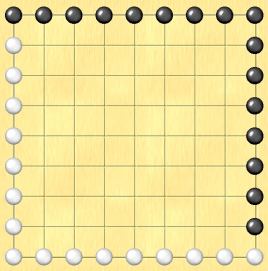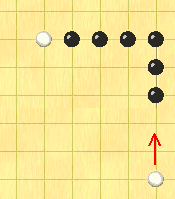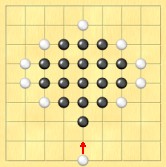

Gundru (Gun-dru, Mig-mang, Ming-mang) is a traditional game from Tibet. It is played on a 9x9 grid with 16 pieces initially placed on the board, and equally many are kept in the reserve. The object is to capture the enemy stones. Stones slide orthogonally in any direction, like the chess rook. Capture is done by enclosing a row of enemy stones between two of one’s own. Many stones can be captured at the same time, both vertically and horizontally. Capture can occur over corners, when a line of stones makes a perpendicular turn anywhere on the board. Captured stones are immediately removed and replaced with friendly stones. When a player has only one stone left, it acquires the capability to capture by the short leap, one jump at a time. Capture is not mandatory. If a player builds an impenetrable fortress and only moves pieces within it, then the other party shall be regarded as the winner. It is important to gain space, thus leaving the enemy with fewer move freedoms. As this game uses the ancient interception capture, it is probably quite old. (There seem to exist other references to Mig-mang or Ming-mang where the rules described are not the correct ones.)
 Capture can also occur of rows of pieces that turn perpendicularly. Captured pieces swap colour.
Capture can also occur of rows of pieces that turn perpendicularly. Captured pieces swap colour.
 In this example all black pieces are captured (swapped). Is Gundru a precursor of Go?
In this example all black pieces are captured (swapped). Is Gundru a precursor of Go?
Reference
Rin-chen Lha-mo (1926). We Tibetans. London: Seeley Service & Co. Limited.
☛ You can download G. Schmidt’s free Tibetan Gundru program here, but you must own the software Zillions of Games to be able to run it. (I recommend the download version.)
☛ Alternatively, you can download the fully free standalone version here.
© Mats Winther (March 2010).